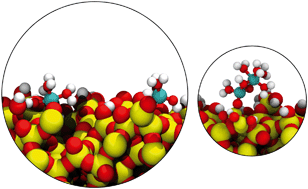Interfacial reactions of Cu(ii) adsorption and hydrolysis driven by nano-scale confinement†
Abstract
Spatial confinement is prevalent in sedimentary rocks and can lead to changes in the chemical behavior at mineral–water interfaces. This includes both deviations in the physico-chemical properties of confined water, when compared to the bulk liquid phase, and subsequent alterations in adsorption chemistry of ions inside nano-scale mineral pores. Here we document contrasting adsorption mechanisms and differences in local coordination environments of copper (Cu2+), depending on whether the ion is adsorbed on non-porous silica surfaces, versus inside 8 nm and 4 nm pores in silica. X-ray absorption spectroscopy, flow micro-calorimetry, and batch adsorption methods together with molecular modeling are used to thoroughly describe the dependence of these adsorption processes on the pore size. We show that confinement within silica pores promotes Cu–Cu interactions and increases the formation of Cu–Cu polynuclear surface complexes. We also demonstrate that the mechanism of Cu2+ adsorption on non-porous versus porous silica is vastly different. The adsorption of Cu2+ on non-porous silica is an endothermic process, whereby Cu2+ undergoes dehydration prior to surface complexation. In contrast, adsorption within nano-scale pores is preceded by only partial dehydration, and significant formation of Cu–Cu polynuclear complexes, which leads to an overall exothermic signal. Interfacial confinement leads to dramatic changes in the adsorption mechanism and speciation, which in turn controls the fate and transport of chemical species in natural environments.

- This article is part of the themed collection: Environmental Science: Nano Cover Art


 Please wait while we load your content...
Please wait while we load your content...
